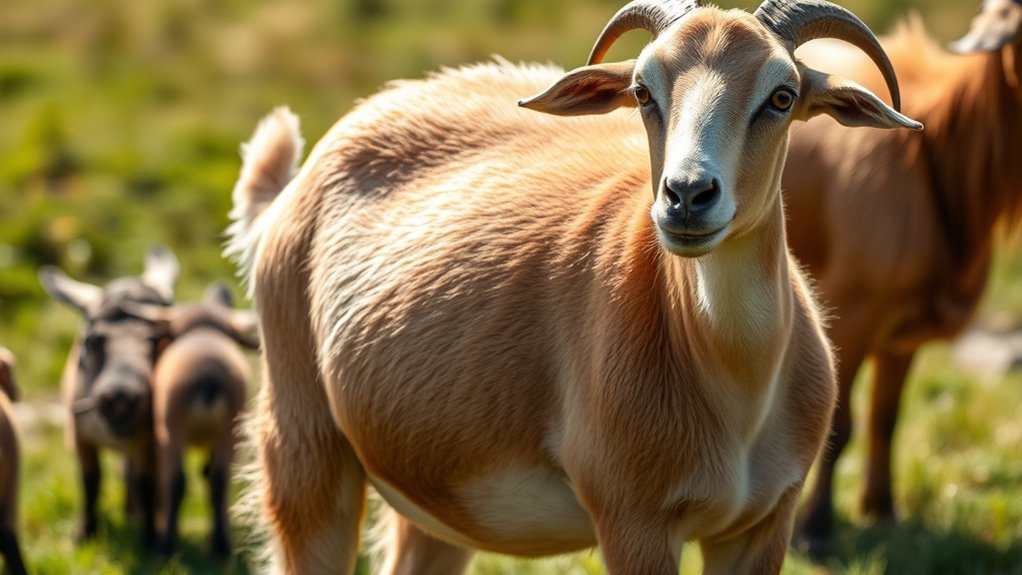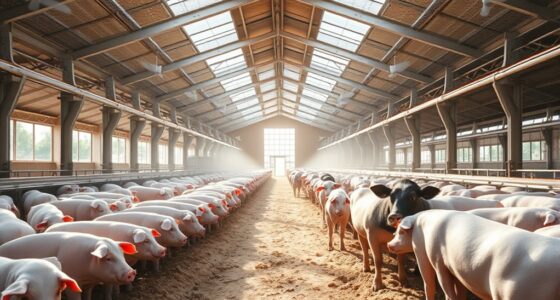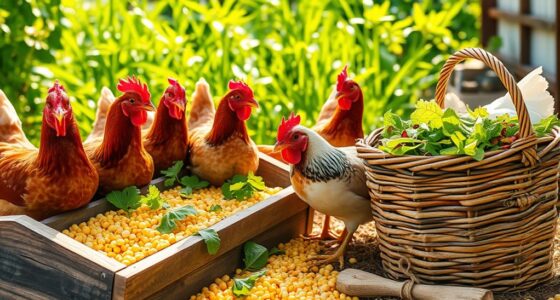If you suspect a goat is pregnant, look for signs like failure to return to heat and changes in behavior, such as increased irritability. In early pregnancy, you might notice udder swelling around six weeks, and the goat may become more withdrawn. As labor approaches, watch for softening pelvic ligaments, a mucus discharge, and restlessness. Keep an eye out for physical changes and behavioral shifts throughout the pregnancy, as they can reveal more about what's happening.
Key Takeaways
- Failure to return to heat after breeding is a strong indication of potential pregnancy in goats.
- Behavioral changes, such as increased irritability or withdrawal, can signal that a goat may be pregnant.
- Udder swelling typically starts around six weeks post-conception, especially noticeable in first-time does.
- Noticeable belly swelling and asymmetrical changes may indicate fetal positioning as pregnancy progresses.
- Observing increased standoffishness and vocalizations can also suggest that a goat is nearing labor.
Early Pregnancy Signs in Goats

When you suspect your goat might be pregnant, look for early signs that can help confirm your hunch. One key indicator is the failure to return to heat; if your doe hasn't gone into estrus, she might be pregnant.
You may also notice behavioral changes—she could become more irritable or withdrawn. While appetite typically remains stable early on, it's essential to monitor her nutritional needs as pregnancy progresses.
Keep in mind that pregnancy toxemia can be a risk in the final weeks, particularly for does carrying multiple fetuses. Factors like breed variations and nutritional management play a role, so staying informed about her health is crucial.
Regular veterinary consultations can help catch any potential issues early on.
Physical Changes During Pregnancy

As your goat progresses through pregnancy, you'll notice several physical changes that signal her condition.
Her udder will begin to swell around six weeks after conception, especially in first-time does, with teats growing longer and thicker. You might also see her belly swell noticeably, particularly in some breeds.
Watch for asymmetrical swelling, as the right side may bulge more due to fetal positioning. Increased appetite is common, though milk production may decrease.
As pregnancy advances, you may even feel the kids moving around three to four months in, with visible kicks against her side.
Lastly, her vulva may swell, and you might notice a clear discharge as she nears labor.
Behavioral Changes to Observe
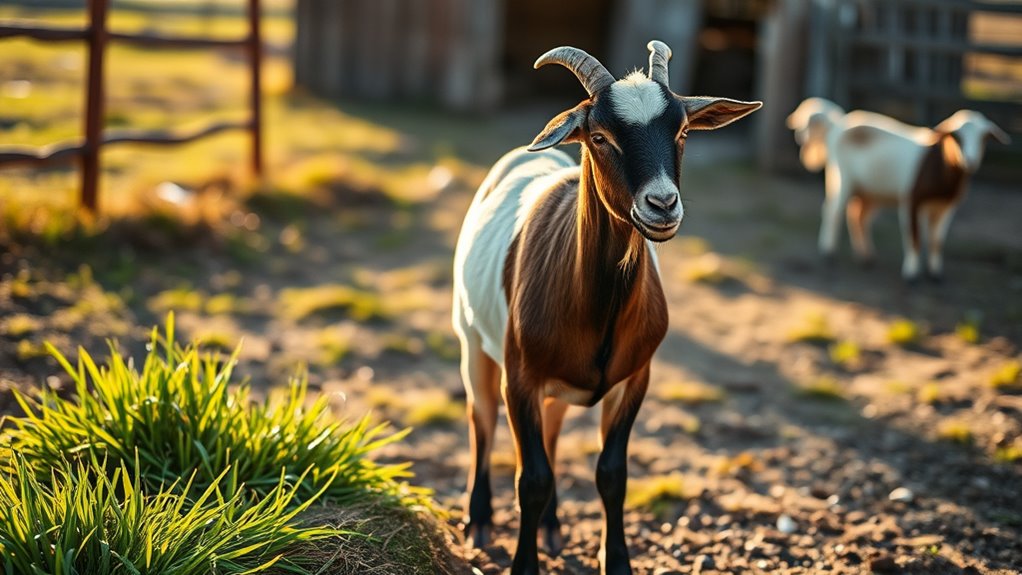
Alongside physical changes, you'll notice significant behavioral shifts in your pregnant goat. As her pregnancy progresses, she might become more standoffish, showing less interest in social interactions that she previously enjoyed.
You may also observe increased vocalizations, which can indicate anxiety. While she spends more time resting, her movement might actually increase as she seeks resources. This change in activity can lead to more grooming behaviors among herd members.
Additionally, she'll likely require more personal space, reflecting her need for comfort. Keep an eye on her overall demeanor; stress responses, such as social withdrawal, can be common.
Recognizing these behavioral changes helps you ensure her well-being during this crucial time.
Pre-Labor Indicators
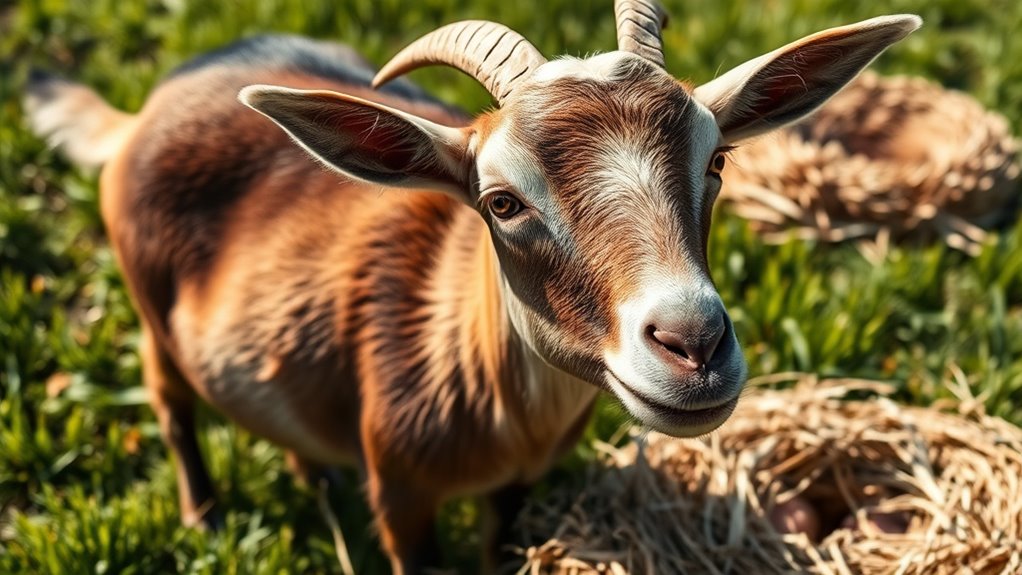
In the final stages of your goat's pregnancy, you'll start noticing distinct pre-labor indicators that signal the approach of kidding.
One key sign is the softening of the pelvic ligaments, making it easier to spot. You may also see a thick, white or yellowish mucus discharge from the vulva, indicating that labor is near.
As kidding approaches, the vulva will become relaxed and loose. Additionally, watch for sunken sides, which show that the kids are positioning themselves for birth.
Restlessness is common, too; does often exhibit unusual behavior as they prepare. Keeping an eye on these changes can help you anticipate the arrival of new kids.
Labor and Kidding Signs
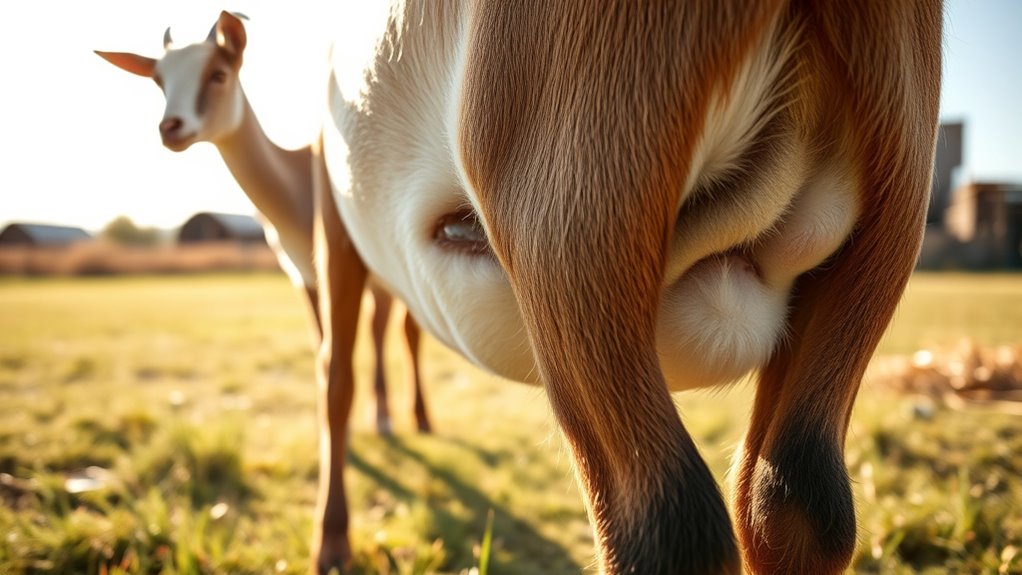
During the labor process, you'll notice several key signs that indicate your goat is about to give birth. First, her udder will fill with milk and become stiff. She may separate from the herd, engaging in nest-building behavior.
Expect restlessness, with her frequently standing and lying down, showing discomfort. Low bleats or grunting sounds often accompany early labor. You might also see a thick string of mucus appearing from her vaginal opening.
As labor progresses, a water bag filled with amniotic fluid will appear. The kid is usually delivered quickly after the head emerges, and it's crucial to clear the newborn's nasal passages right away.
As the birthing process continues, the emergence of a water bag signals that the kid's arrival is imminent.
Watch for maternal behavior, as she'll likely lick or nuzzle her kid.
Frequently Asked Questions
How Long Is a Goat's Gestation Period?
A goat's gestation period typically lasts between 140 to 150 days, which is about five months.
This duration can vary slightly based on factors like breed and nutrition.
You'll often see goats giving birth to twins or triplets, and the kids usually have an almost equal chance of being male or female.
Understanding this timeframe helps you prepare for the arrival of new kids and ensures you're ready for the birthing process.
Can You Use a Home Pregnancy Test for Goats?
You can't use a home pregnancy test for goats. Those tests are designed for humans and won't give accurate results for your goats.
Instead, you should consider blood tests or ultrasounds, which require veterinary assistance. These methods will provide reliable confirmation of pregnancy.
It's essential to consult with a vet to ensure your goat's health and well-being throughout the process, especially if you suspect she might be pregnant.
What Breeds of Goats Are More Prone to Complications During Pregnancy?
Think of pregnancy in goats like navigating a winding road; some breeds hit bumps more often than others.
Boer goats are particularly prone to complications like pregnancy toxemia, especially if they're over-conditioned. Dairy breeds can struggle too, facing issues like lactational ketosis due to high milk production demands.
Under-conditioned does also face risks, so always keep an eye on their health and adjust their diet to help steer clear of trouble.
How Can Diet Affect a Goat's Pregnancy?
Diet plays a crucial role in a goat's pregnancy. You need to ensure they get enough energy and protein to support fetal development and maternal health.
A balanced diet can prevent complications like pregnancy toxemia and ketosis, impacting both the mother and kids. By monitoring their nutritional intake and making necessary adjustments, you can promote healthy growth and reduce risks, ultimately enhancing milk production postpartum.
Always consult a vet for tailored dietary recommendations.
When Should I Consult a Vet During Goat Pregnancy?
When it comes to goat pregnancy, it's smart to consult a vet sooner rather than later.
You should seek advice around 45–60 days for early confirmation. If you notice any complications like fetal distress, don't hesitate to reach out.
For fetal sexing and counting, aim for a vet visit between 55–70 days.
Conclusion
As you embark on the journey of goat parenthood, keep your eyes peeled for those subtle signs that whisper of new life. From the gentle swell of her belly to the softening of her demeanor, each clue is a brushstroke on the canvas of her pregnancy. When the time comes, the air will shimmer with anticipation, and you'll witness the miracle of life unfold before your eyes. Embrace the adventure—your herd's next chapter is just around the corner!

